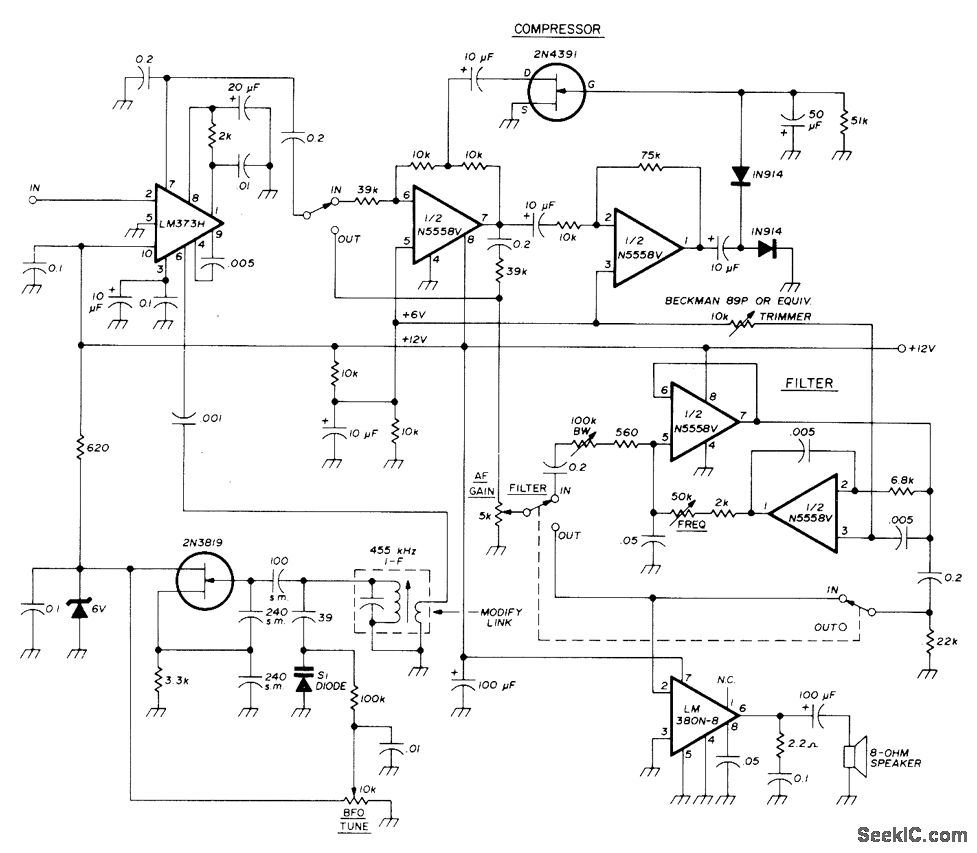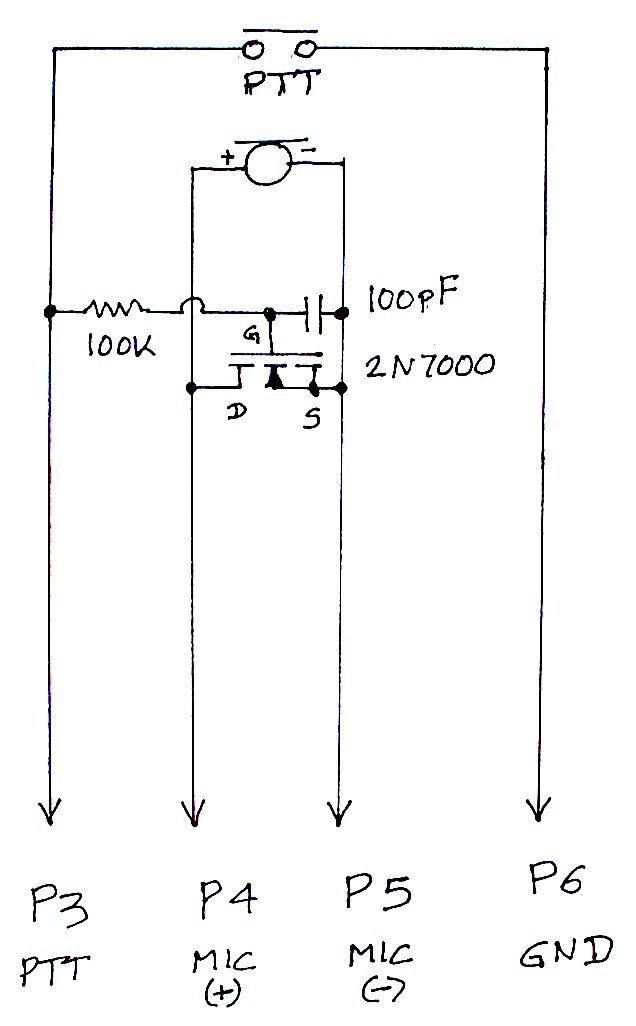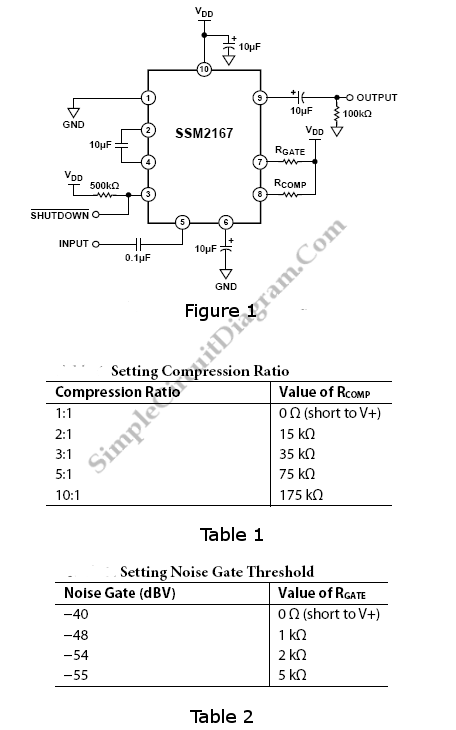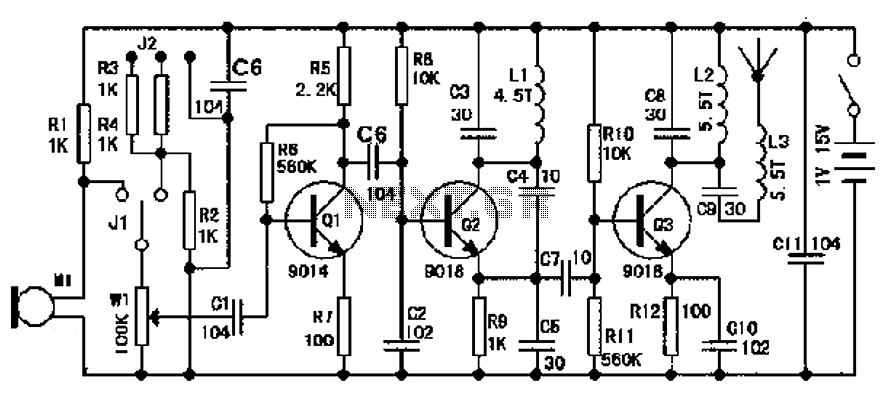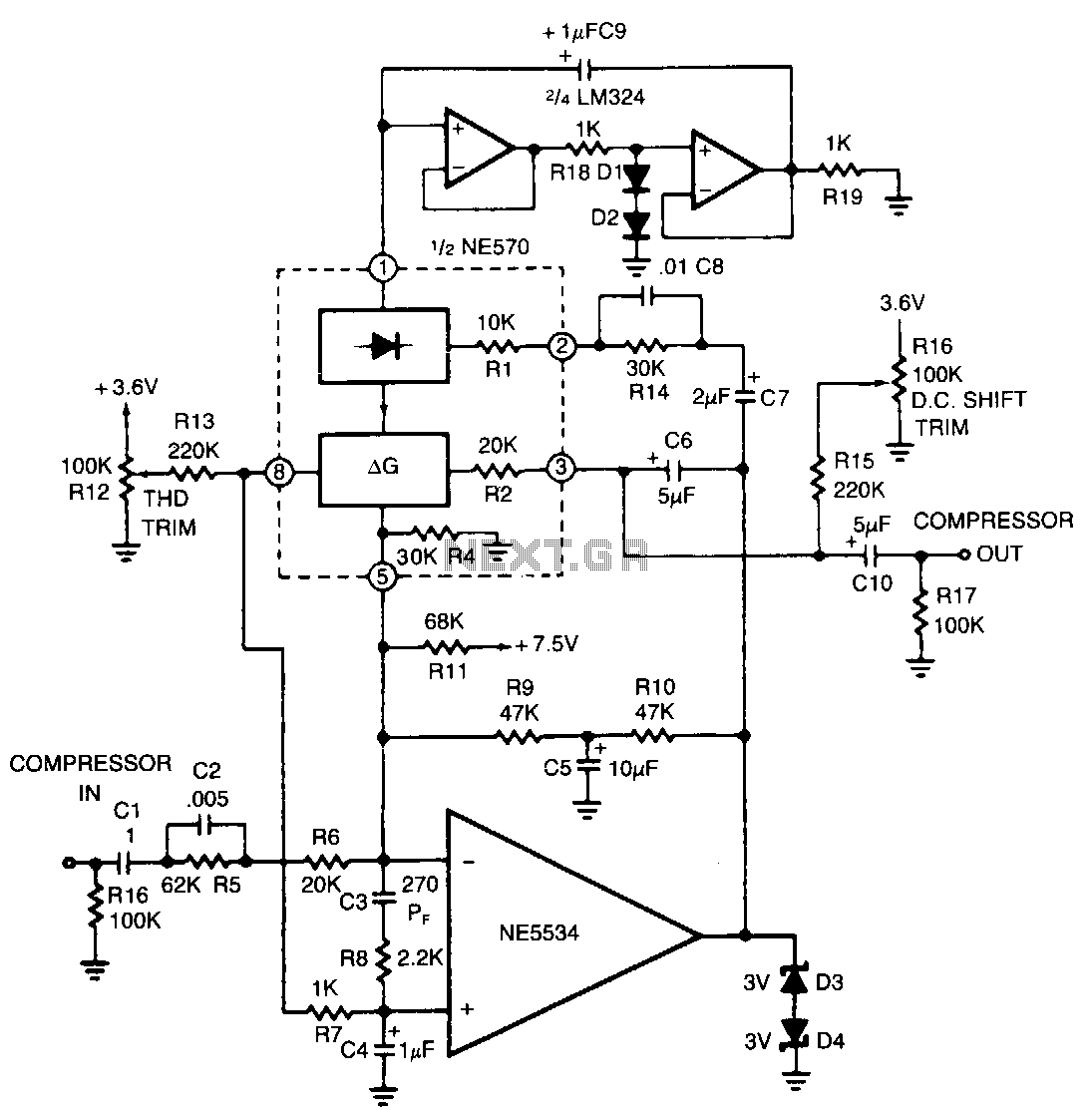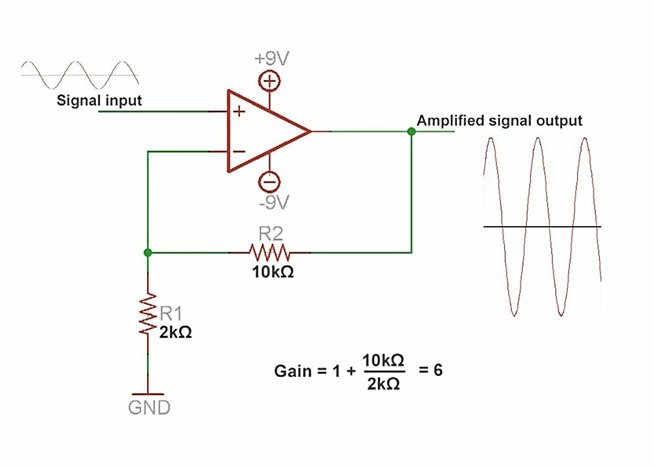
Compressor For Electret Microphone
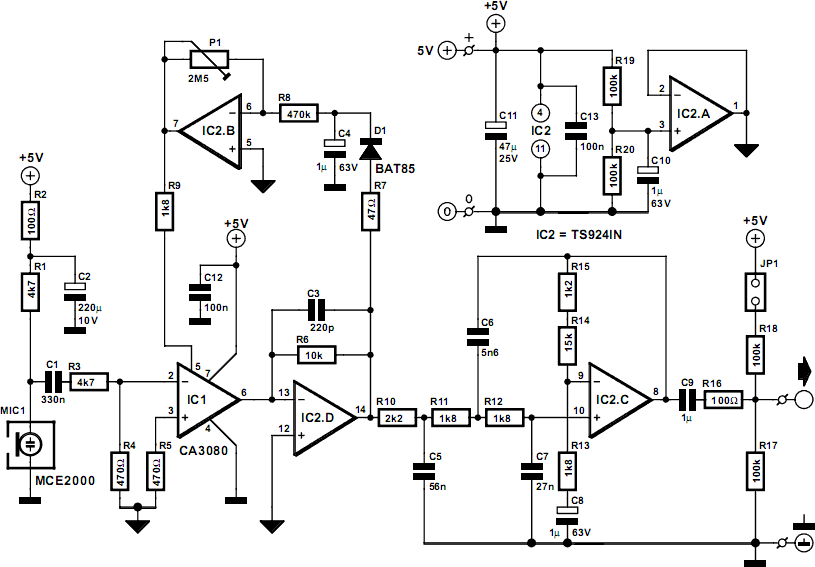
The FM Remote Control Receiver, found in the Infra-red circuits section of this website, features a connector that provides an analogue output. To create a simple intercom or public address (P.A.) system, a microphone pre-amplifier is required to ensure the transmitter outputs a signal at the appropriate level. This circuit fulfills that role. The design is adapted from a previously published circuit (AM Modulator for Intercom), with modifications to enable operation with a 5 V supply from the transmitter module. The circuit employs a single operational transconductance amplifier (OTA), specifically the CA3080, which has distinct characteristics compared to the dual CA3280. The quad op-amp used is the rail-to-rail TS924IN from ST. The turnover frequency of the filter (3rd order 1 dB Chebyshev) has been marginally increased to enhance speech intelligibility, now approximately 5.5 kHz. The filter amplifies the signal by a factor of 10. Due to component tolerances and imperfections in the op-amp, the filter's characteristics may deviate from the ideal. In the prototype, it was necessary to alter R15 to 2.7 kΩ to correct the response curve. Variations in the DC current at the OTA output and the resulting offset variations at the output of the current/voltage converter IC2d necessitate a significantly lower gain for IC2d compared to the previous design to prevent the output from reaching the supply voltage at low signal levels. Consequently, R6 has been reduced by a factor of 10, resulting in a 20 dB reduction in circuit gain, which is compensated for in the filter. The output signal amplitude from IC2d is fed back as a control current to the OTA via peak rectifier D1/C3 and inverting amplifier IC2b, with R7 limiting the loading on IC2d. P1 allows for adjustment between fixed gain and maximum compression. The circuit's effect is illustrated in Figure A, where 0 dBr corresponds to 100 mV. The maximum gain, with P1 set to maximum compression, is around 48 dB (250 Ω) for small signals, while the minimum gain is approximately 20 dB (10 Ω). When the gain is fixed (P1 shorted), it is about 42 dB (125 GΩ). The middle curve was measured with P1 at its midpoint. The fixed gain curve does not terminate at the graph's edge because it represents the maximum output level of 25 dBr (approximately 1.76 V or 5/2). Figure B depicts the frequency response, with the low turnover frequency primarily determined by C8 (and to a lesser extent by C1), approximately 120 Hz. The circuit's current consumption is around 7 mA. When powered by batteries, it is recommended to use three AA cells, as the circuit operates satisfactorily at 4.5 V. For a higher supply voltage (up to 12 V for the TS924IN and 30 V for the CA3080), it is important to consider the voltage across the electret microphone, ensuring that the maximum current through R9 (IABC) does not exceed 2 mA. Assuming a maximum current of 1 mA and an output voltage from IC2b of half the supply voltage (2.5 V), R9 can be calculated as (2.5 - 0.7) V / 1 mA = 1.8 kΩ. The 0.7 V represents the potential between pin 5 and ground. For a larger safety margin, R9 can be calculated using the full supply voltage and a current of 2 mA: (5 - 0.7) V / 2 mA = 2.2 kΩ (rounded upwards). This circuit and the transmitter module can share the same 5 V supply. Since the transmitter requires a DC offset at its input, a resistor is connected to +5 V via a jumper to bias the output to half the supply voltage. When the jumper is open, R17 acts as a load resistor when the output is not in use.
The FM Remote Control Receiver circuit is designed for efficient operation in intercom and P.A. applications. The use of the CA3080 OTA allows for precise control of the gain, while the TS924IN quad op-amp ensures optimal signal processing. The adjustments to component values, such as R15 and R6, demonstrate the importance of fine-tuning in achieving desired performance characteristics, particularly in terms of gain and frequency response. The feedback mechanism involving D1/C3 and IC2b is crucial for maintaining stability and preventing distortion in the output signal. The design considerations for power supply and component ratings reflect a comprehensive understanding of the circuit's operational limits, ensuring reliable performance across various conditions. The recommendation for battery use emphasizes the circuit's versatility and adaptability to different power sources, making it suitable for portable applications. Overall, this circuit exemplifies a well-engineered solution for audio amplification and signal processing in remote communication systems.The FM Remote Control Receiver` (available on this website in Infra-red circuits section) has a connector where an analogue output is made available. To make a simple intercom or P. A. system the associated transmitter needs a microphone pre-amplifier that outputs a signal at the correct level.
And that is exactly the function of this circuit. Actu ally, this design is adapted from a circuit published last year (AM Modulator for Intercom`). A few things have been changed so that it can work with the 5 V supply from the transmitter module. The OTA (IC1) used here is the single version (CA3080), which has slightly different characteristics from the dual CA3280. The quad opamp is the same rail-to-rail TS924IN, made by ST. The turnover frequency of the ¬lter (3rd order 1 dB Chebyshev) has been increased slightly to improve the intelligibility of speech and is now about 5.
5 kHz. The ¬lter now ampli ¬es the signal by a factor of 10. In practice it is possible that due to various tolerances and the fact that the opamp is not perfect, the ¬lter characteristic shows some deviation from that required. In our prototype it was necessary to change R15 into 2k7 to straighten the response curve. The DC current variation at the output of the OTA and the resulting offset variation at the output of current/voltage converter IC2d is such that the gain of IC2d has to be substantially smaller than in the old` design.
Otherwise the output could easily rise to the supply voltage at low signal levels. The value of R6 has therefore been made smaller by a factor of 10. This has reduced the gain of the circuit by 20 dB, which is compensated for in the ¬lter. The amplitude of the signal from IC2d is fed back as a control current to the OTA by peak recti ¬er D1/C3 and inverting ampli ¬er IC2b. R7 limits the loading on IC2d. P1 can be used to adjust the amplifier between a fixed gain and maximum compression. Figure A shows clearly what effect the circuit has. 0 dBr corresponds to 100 mV. The maximum gain, with P1 set to maximum compression, is about 48 dB (250 ) for small signals. The minimum gain is about 20 dB (10 ). The OTA is then slightly overdriven and the distortion becomes several percent! With a ¬xed gain selected (P1 shorted) the gain is about 42 dB (125 G—). The middle curve was measured with P1 in its central position. The curve drawn for a ¬xed gain (the straight line) doesn`t ¬nish at the edge of the graph because the end of the line corresponds to the maximum possible output level, which is 25 dBr (‰ 1.
76 V or 5 / 2 2). Figure B shows the frequency response. The low turnover frequency is mainly determined by C8 (and to a lesser extent by C1) and is about 120 Hz. The current consumption is about 7 mA When the circuit is battery powered we recommend the use of three AA cells, because the circuit still works perfectly at 4.
5 V. If you want to use a higher supply voltage (maximum 12 V for the de TS924IN and 30 V for the CA3080, but you should also think of the voltage across the electret microphone!) you have to keep in mind that the maximum current through R9 (which is IABC) is only 2 mA. When we consider a maximum chosen current of 1 mA and the maximum output voltage of IC2b (half the supply voltage, which is 2.
5 V), then the value of R9 should be (2. 5 0. 7) V / 1 mA = 1. 8 k. The value of 0. 7 V corresponds to the potential between pin 5 and earth. For a larger safety margin R9 is calculated with the full supply voltage and a current of 2 mA: (5 0. 7) V / 2 mA = 2k2 (rounded upwards). Of course the regulation will then be different (a little less gain). This circuit and the transmitter module can therefore be fed from the same 5 V supply. Because the transmitter requires a DC offset at its input, a resistor is connected to +5 V via a jumper, which biases the output to half the supply voltage.
With the jumper open R17 functions as a load resistor when the output is n 🔗 External reference
The FM Remote Control Receiver circuit is designed for efficient operation in intercom and P.A. applications. The use of the CA3080 OTA allows for precise control of the gain, while the TS924IN quad op-amp ensures optimal signal processing. The adjustments to component values, such as R15 and R6, demonstrate the importance of fine-tuning in achieving desired performance characteristics, particularly in terms of gain and frequency response. The feedback mechanism involving D1/C3 and IC2b is crucial for maintaining stability and preventing distortion in the output signal. The design considerations for power supply and component ratings reflect a comprehensive understanding of the circuit's operational limits, ensuring reliable performance across various conditions. The recommendation for battery use emphasizes the circuit's versatility and adaptability to different power sources, making it suitable for portable applications. Overall, this circuit exemplifies a well-engineered solution for audio amplification and signal processing in remote communication systems.The FM Remote Control Receiver` (available on this website in Infra-red circuits section) has a connector where an analogue output is made available. To make a simple intercom or P. A. system the associated transmitter needs a microphone pre-amplifier that outputs a signal at the correct level.
And that is exactly the function of this circuit. Actu ally, this design is adapted from a circuit published last year (AM Modulator for Intercom`). A few things have been changed so that it can work with the 5 V supply from the transmitter module. The OTA (IC1) used here is the single version (CA3080), which has slightly different characteristics from the dual CA3280. The quad opamp is the same rail-to-rail TS924IN, made by ST. The turnover frequency of the ¬lter (3rd order 1 dB Chebyshev) has been increased slightly to improve the intelligibility of speech and is now about 5.
5 kHz. The ¬lter now ampli ¬es the signal by a factor of 10. In practice it is possible that due to various tolerances and the fact that the opamp is not perfect, the ¬lter characteristic shows some deviation from that required. In our prototype it was necessary to change R15 into 2k7 to straighten the response curve. The DC current variation at the output of the OTA and the resulting offset variation at the output of current/voltage converter IC2d is such that the gain of IC2d has to be substantially smaller than in the old` design.
Otherwise the output could easily rise to the supply voltage at low signal levels. The value of R6 has therefore been made smaller by a factor of 10. This has reduced the gain of the circuit by 20 dB, which is compensated for in the ¬lter. The amplitude of the signal from IC2d is fed back as a control current to the OTA by peak recti ¬er D1/C3 and inverting ampli ¬er IC2b. R7 limits the loading on IC2d. P1 can be used to adjust the amplifier between a fixed gain and maximum compression. Figure A shows clearly what effect the circuit has. 0 dBr corresponds to 100 mV. The maximum gain, with P1 set to maximum compression, is about 48 dB (250 ) for small signals. The minimum gain is about 20 dB (10 ). The OTA is then slightly overdriven and the distortion becomes several percent! With a ¬xed gain selected (P1 shorted) the gain is about 42 dB (125 G—). The middle curve was measured with P1 in its central position. The curve drawn for a ¬xed gain (the straight line) doesn`t ¬nish at the edge of the graph because the end of the line corresponds to the maximum possible output level, which is 25 dBr (‰ 1.
76 V or 5 / 2 2). Figure B shows the frequency response. The low turnover frequency is mainly determined by C8 (and to a lesser extent by C1) and is about 120 Hz. The current consumption is about 7 mA When the circuit is battery powered we recommend the use of three AA cells, because the circuit still works perfectly at 4.
5 V. If you want to use a higher supply voltage (maximum 12 V for the de TS924IN and 30 V for the CA3080, but you should also think of the voltage across the electret microphone!) you have to keep in mind that the maximum current through R9 (which is IABC) is only 2 mA. When we consider a maximum chosen current of 1 mA and the maximum output voltage of IC2b (half the supply voltage, which is 2.
5 V), then the value of R9 should be (2. 5 0. 7) V / 1 mA = 1. 8 k. The value of 0. 7 V corresponds to the potential between pin 5 and earth. For a larger safety margin R9 is calculated with the full supply voltage and a current of 2 mA: (5 0. 7) V / 2 mA = 2k2 (rounded upwards). Of course the regulation will then be different (a little less gain). This circuit and the transmitter module can therefore be fed from the same 5 V supply. Because the transmitter requires a DC offset at its input, a resistor is connected to +5 V via a jumper, which biases the output to half the supply voltage.
With the jumper open R17 functions as a load resistor when the output is n 🔗 External reference
